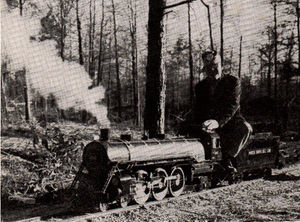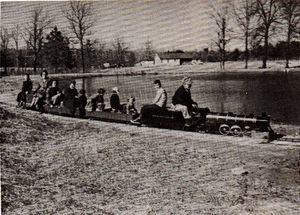Myrtle Grove Belt Line
W.P. Johnston
Box 991
El Dorado, Arkansas
The North American Live Steamer, Volume 1 Number 6
I enclose a couple of photographs of my railroad, which I call the Myrtle Grove Belt Line. I have broken about every rule in the book in building this layout. About 50% of it is welding, because I have a good welding outfit, the balance machining. I used castings from Irene Lewis for the drive wheels and cylinders, building up the rest from welded steel. My locomotive is a 1-1/2 inch Pacific. I have a steel caboose, complete with working doors and glass windows. It is welded steel, plenty strong enough for two adults to ride upon. Then I have a tank car, in which I carry water and two gondola cars with seats. Little kids are fascinated by the latches on the caboose doors, but the engine gets the most attention from the grown-ups. We are using diesel oil for fuel, after having an unfortunate experience with gasoline. Came near losing the whole layout, and my son along with it. The burner we are using now works very well, and makes plenty of steam, but of course we have to clean flues oftener than we did with gasoline. We have a combination engine house and turn table, and have just completed a special four wheel trailer to haul our equipment in, as our railway is a mile from my shop. The track runs around a pond, with two steel trestles. Track is 620 feet long, almost a scale mile.
Now there is where the departure from standard starts. The rail is 1 inch by 1/2 inch channel, with the smooth side in, welded to ties made of 3/4 inch round steel rods 12 inches long every six inches. All the railroad men said it could not be done, but I did, and it worked out fine. I used steel tires because I had the material and the welding equipment, and could lay them faster. I used steel channel for the rails because it was readily obtainable at 8-1/2 cents per foot whereas aluminum rail would have been 25 cents per foot, plus freight from California. Also, it would not weld well to steel.
It took four men four days to lay and weld the track. It was a little rough when finished, but subsequent straightening operations have helped it a whole lot. Anyway, we have had very few derailments. Having no wooden ties, I use a weed burner to kill the grass along the right of way.
The locomotive is the second I have built the first being a 1/2 inch scale, also a Pacific. I spent eight years, off and on, building the first engine, but my son and I built the big one in a little less than one year. The frame is built up of 3/4 inch square CRS steel, welded of course. And of course it warped a little, but with a gas torch, straight edge, and a fairly good eye, we soon had it as straight as a die. Main bearings are Timken roller. I attached short lengths of flexible tubing to each main bearing, and brought them out to the side, where I could get at them easily for greasing. We have an excellent whistle, which is about 1-1/2 inch by 14 inch, has four tones, and fastened under the left running board. Smoke box is split, which I thought was my own idea, but read in The North American Live Steamer about the same idea recently. Also I used the idea of a slide valve throttle, actuated by a rod running through the dry pipe to the boiler head. I did not like the idea of having a stuffing box in the hot smoke box. The tender has two compartments, front for water and back for fuel. We carry about 25 pounds pressure on the fuel tank, so that the fuel comes to the burner O.K. Tender is riveted instead of welded, but the rivets on the caboose are imitation, but a very good imitation, as you can hardly tell they are not real rivets. You published a picture of my Pacific in your first issue, when I only had the frame and chassis finished. All in all, my outfit is not perfect, but it sure runs and pulls well, and we are pretty well satisfied with it.
Being the only live steamer in this vicinity who has actually constructed a small railroad, I get a little lonesome for fellow live steamers, so if anyone lives within 300 miles of El Dorado, Arkansas and wants to visit me, they are more than welcome. I belong to the Southern California Live Steamers. I was out to their meet at Lomita in 1954, and am going out to Santa Barbara next month to visit my good friend Seymour F. Johnson at his Oak Grove ranch and ride his Goleta Valley line. Maybe I can visit some of you Live Steamers up Michigan way next year.

